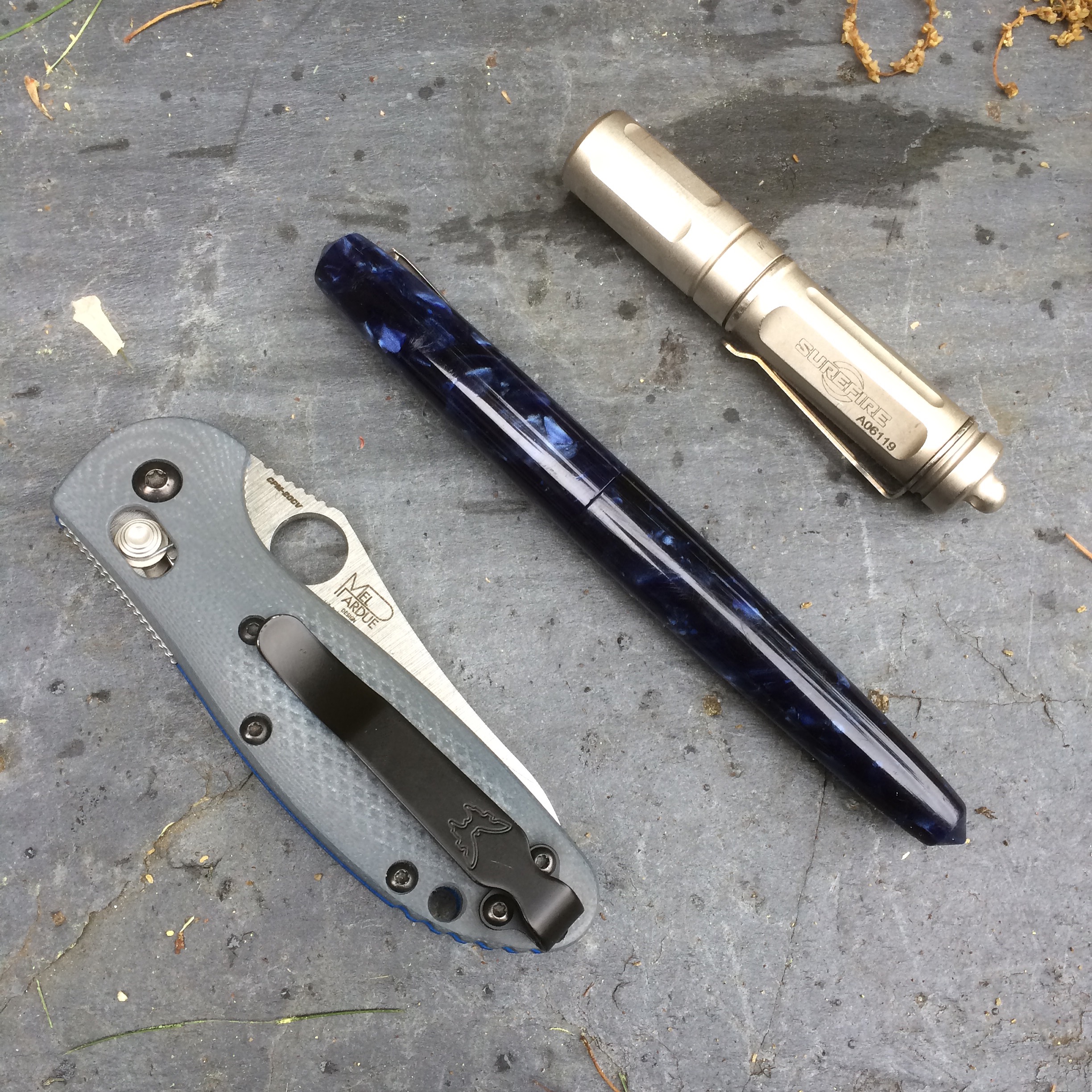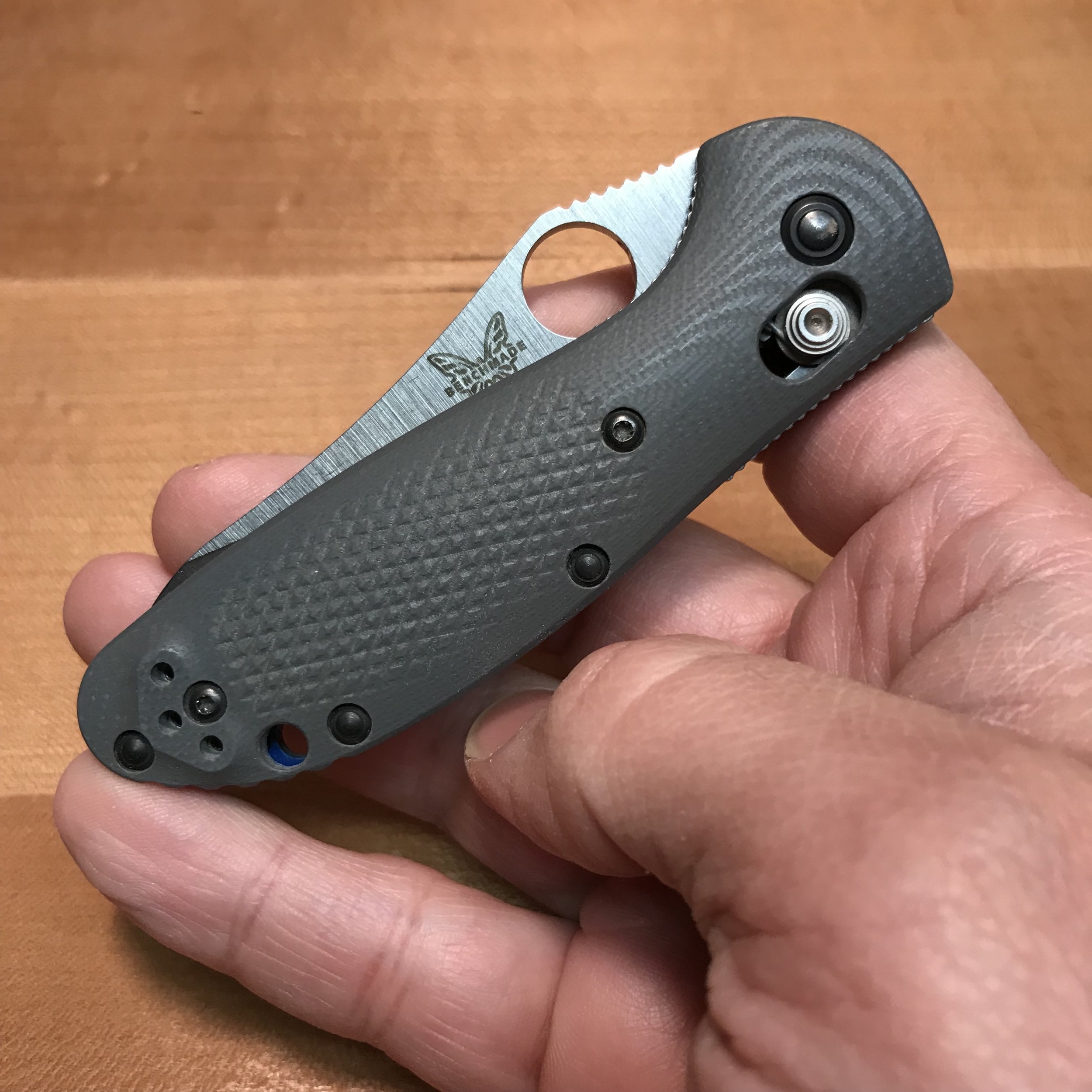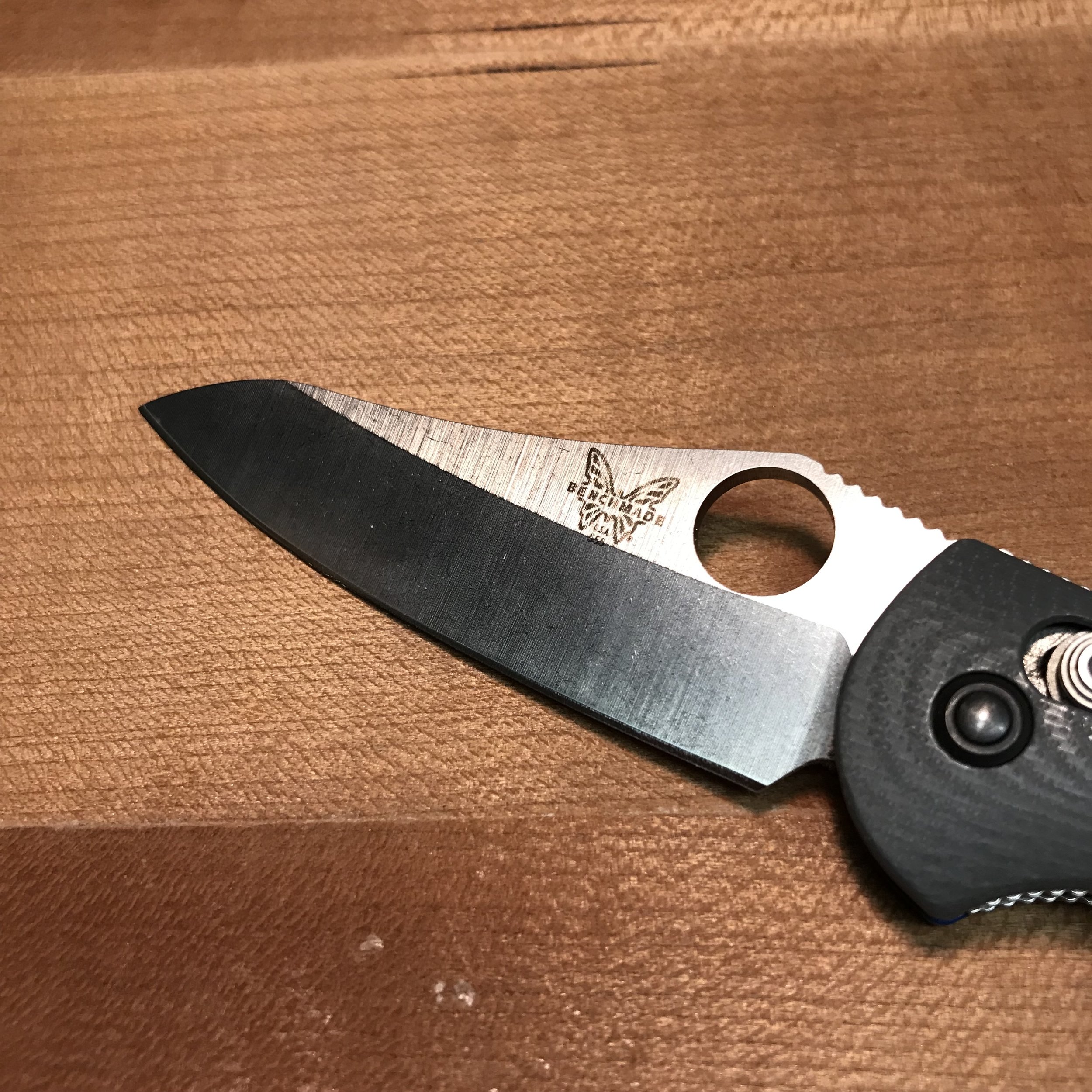The Genius of the Mini Grip
Over the past ten months I have started using the Benchmade Mini Grip (here are links to the 555-1 version and the new standard S30V version) as a reference in my videos. In doing so, I have come to appreciate the Mini Grip a lot more. This isn’t just a good knife, it is an all time classic. Problem is, like with Bill James’s assessment of Darrell Evans, features of the knife conspire to hide its greatness. All too often people ignore the Mini Grip over design darlings from Spyderco like the Delica, the Native, or Paramilitary 2. Great knives, to be sure, but the Mini Grip deserves a spot among them. Think of this article as a tip of the hat to the great Mel Pardue, designer of the Mini Grip.
First, let’s clear the land of the largest stone. The Axis lock is exceptionally hard to make well. Even Benchmade, progenitor of the lock design, has struggled making it throughout its production history. Now, as the patent has lapsed, we are seeing others use it and they have brought innovation to the machining and design resulting in better tolerances. Benchmade itself has also started producing the lock with better fit and finish. My Mini Grip, one of the early runs of the 555-1, has exhibited zero bladeplay in any direction since I bought it almost four years ago. The limited edition Valet I bought is similarly tight as a drum.
With that concern out of the way, let me lay out why I think the Mini Grip is a genius design and why it is so criminally underrated in this era of $500 TFFs. Note that I am breaking my long-held prohibition on the word “genius” to describe a knife design. I am breaking it here because I think it is merited.
Genius
Fully Ambidextrous
I am not left handed. Nor am I a person that thinks EVERY knife needs to cater to 10% of the market. I prize the Mini Grip in this regard because it shows a subtle mastery of the form when a knife can be fully ambidextrous. It is as if the designer is saying to us “Oh yes, and by the way, the knife is full ambi.” The fact that the knife is so functional that there is literally no disadvantage approaching it from either side is a sign that the knife is skillful drawn up.
Great B:H
So often in my video overviews I bring the Mini Grip into the frame and show that yes, while the blade its about the same size, knife X has a bigger handle. Over and over again, this has happened. It is truly amazing to see the Mini Grip stack up against some rando knife that I thought had killer ratios and realize that well, no, it doesn’t. To me, the b:h ratio is the knife designer’s way of winking at all of us knife nerds, as if to indicate that he or she really was paying attention. And unlike a lot of ratio champions, the Mini Grip does not feel weird or odd or artifically stretched. Its just a damn solid knife with a superior b:h ratio. The b:w ain’t bad either, with the fat version, the G10 version, coming in just under 3 ounces.
Lanyard Hole
No, I have not changed my mind—lanyard holes are still unnecessary. The reason I bring it up here is because Benchmade’s implementation of the lanyard hole is perfect. Its there, its useable, but it is 100% out of the way. It has ZERO impact on the design. Just in case anyone is reading. THIS is how you do it. Not in the path of the blade. Not in a place that screws up the knife handle. There, but out of the way.
Evolved
The original Mini Grip had a thumb stud. Then a thumb oval. Then a thumb hole but with hollow Grivory handles. Then the 555-1 came out with a thumb hole and G10 handles. The knife has had three blade shapes, three standard steels, and a half dozen handle colors. Like with the best in Spyderco’s line up, the Mini Grip (and the larger Griptilian) are knives that have, over time, evolved.
Easy Does It
I can still hear my grandfather in my head, everytime I pick up the Mini Grip. “Now, son easy does it.” There are no outlandish elements here. No moku ti (though the Gold version did have an ironwood inlay), no duplex grind, no grip inserts just good solid features. The sharpening choil is very good, an upgrade over any similarly sized or priced Spyderco. The handle shape is pleasant without any hotspots. It naturally fits the shape of your hand. The hump for the opening hole isn’t that tall and acts as a perfect ramp for your thumb. The clip is simple and effective. Mel Pardue, like my grandfather, must have been in the “Easy Does It” camp. And as I get older I appreciate that camp a lot more.
Steel
For a long time the Mini Grip’s design joy was met with steel meh-ness. Then the 555-1 came out and we got a Mini Grip with state of the art steel. 20CV is still pretty darn good (for the reader that sent me an email about a year ago regarding swearing in my written pieces, I edited that last part just for you). And it is well ground, and thin. Not so thin that it is a concern, but thin enough to slice and not split an apple. The great blade shape of the thumb hole version makes this one of my favorite blades out there—good shape, good grind, good steel. And remember knife are for cutting so all that stuff is important. With the 555-1, we have a knife that reaches the zenith of what I think a rational argument can justify in knife purchasing. Beyond this and you are spending money for reasons other than performance.
Underrated
Axis Lock Variances
There is no way around it—problems with the tolerances of the Axis lock, have, over time, caused quite a few to just foreswear Axis locks all together. I get it. I have had a few Axis locks that were terrible. But in the past two years they have gotten much much better. Furthermore, with the patent gone, there is likely to be a lot of innovation in the Axis lock space. One only needs to look at what custom maker Will Moon has done with his Spindle Lock design. The Axis locks I have had on knives over the last two years have been very, very good. But memories linger and there is no question the Axis lock has had a spotty track record, especially with blade play. Consider this a notice—these are not your father or your big brother’s Axis locks.
Hollow Handles
While a lot of knives in this price range have G10, the original Mini Grip had a Grivory (FRN) handle and there was some empty space in there. Even the Delica, which also sported the same or similar material, used a nested liner to give the knife a solid feeling. This notable historical criticism, of course, no longer applies to the 555-1 as it is sculpted G10.
Not Flippable
As much work as Benchmade has done to make the Axis lock smoother, it still lacks the snappy, addictive action that many knife knuts want in their fidget toys...um...folders. This kinetic, crisp action has become a default test for “quality” these days in the way that walk and talk was for slipjoints. And if that is the bar for quality, then the Mini Grip didn’t clear the hurdle. I think this is a misnomer, sort of like judging cars by how solid their doors were (as seen in the Mercedes campaign from a few years ago). The reality is judging cars by their doors and knives by their flipping action is a bit silly as both are a side effect of quality, not quality itself. Unfortunately, that is where we are right now and the current moment values flip over cut and in that regard Mini Grip is a bit out of style.
Too Many Variants
Let’s be candid—there are too many different Griptillian models. There is a small and a large. A clip point and a sheepsfoot. There is a tanto. There are models with thumb studs and those without. There have been two different hole shapes. You can get ones with half serrated blades and those with plain edges. And you can get the knife with at least two different handle materials, three different steels, and a Gold class version or two. And none of this touches the custom version you can order from Benchmade itself. While variation is a good thing in terms of consumer choice, at some point so much variation works against the knife and brand identity. What is the standard Mini Grip? Probably the (now) S30V version with blade FRN handles and a thumbstud, but I am not sure and I have reviewed knives for 9 years. The issue here is dilution. There are a ton of variants of the Delica too, but it is clear that most are sprint runs, something that comes and goes. It is a variant with a life span.
And then there is this problem—the standard version is pretty clearly not the best version. Other than steel, the standard version of the Delica IS the best version. But with the Mini Grip, the thumb hole version has both a better blade shape and better deployment method. If the 555-1 was the standard Mini Grip, the one produced in the most numbers, and the one that people think of first when the words “Mini Grip” are uttered, then things would be different. As it is, no one knife is called to mind when someone asks “What’s a Benchmade Mini Grip look like?” And that is a problem.
In his seminal book on baseball, the Bill James Historical Abstract, 2nd Edition, Bill James wrote the following about Darrell Evans: “players that do several things well are underrated.” This principle applies to knife design as well. Knives like the Mini Grip are underrated because it does a bunch of things very well. Its not a fit and finish showcase like the Sebenza or a bling magnet like a Reate. But what it does, it does quite well and there are subtle details, like the amazing B:H that vault this to the top of my list of favorite knives. In this era of $600 TFF from production companies, don’t let this quiet superstar go unowned.




